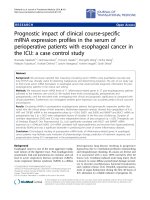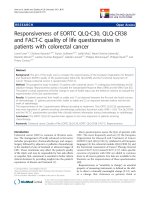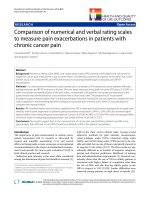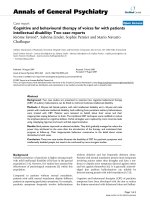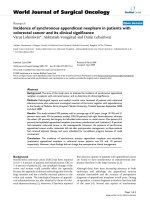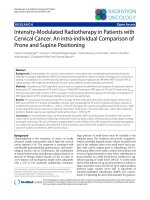Trends in risk classification and primary therapy of Japanese patients with prostate cancer in Nara urological research and treatment group (NURTG) – comparison between 2004–2006, 2007–2009,
Bạn đang xem bản rút gọn của tài liệu. Xem và tải ngay bản đầy đủ của tài liệu tại đây (890.45 KB, 7 trang )
Tanaka et al. BMC Cancer (2017) 17:616
DOI 10.1186/s12885-017-3637-2
RESEARCH ARTICLE
Open Access
Trends in risk classification and primary
therapy of Japanese patients with prostate
cancer in Nara urological research and
treatment group (NURTG) – comparison
between 2004–2006, 2007–2009, and
2010–2012
Nobumichi Tanaka1* , Yasushi Nakai1, Makito Miyake1, Satoshi Anai1, Takeshi Inoue1, Tomomi Fujii2,
Noboru Konishi2 and Kiyohide Fujimoto1
Abstract
Background: To assess the trends in risk classification and primary therapy of Japanese prostate cancer patients
who were diagnosed between 2004 and 2012.
Methods: A total of 7768 patients who were newly diagnosed with prostate cancer at Nara Medical University and
its 23 affiliated hospitals between 2004 and 2012 were enrolled. The trends in risk classification and primary therapy
in 2004–2006 (prior period), 2007–2009 (middle period), and 2010–2012 (latter period) were compared.
Results: The proportion of high-risk and worse patients significantly decreased in the latter period compared to the
prior period (p < 0.001), while that of intermediate-risk patients significantly increased over the years (p < 0.001).
The proportion of primary androgen deprivation therapy (PADT) was 50% in the prior period, 40% in the middle
period, and 30% in the latter period, respectively. The proportions of radiation therapy and active surveillance
significantly increased. The proportion of radical prostatectomy remained similar over these periods (30%). The
primary therapy was significantly different between the three periods (p < 0.001).
Conclusions: High-risk patients significantly decreased in the latter period. The use of PADT also significantly
decreased, while radiation therapy and active surveillance significantly increased over these periods.
Keywords: Primary therapy, Primary androgen deprivation therapy, Radical prostatectomy, Radiation therapy, Risk
classification, Active surveillance
Background
Previous reports of the Japanese Urological Association
indicated a distinctive trend in the use of primary androgen deprivation therapy (PADT) as the primary therapy
for Japanese prostate cancer patients [1, 2]. We have also
previously reported the trends in risk classification and
primary therapy of patients with prostate cancer between
* Correspondence:
1
Department of Urology, Nara Medical University, Nara, Japan
Full list of author information is available at the end of the article
2004 and 2006 in the Nara Uro-Oncological Research
Group (NUORG) registry. We found significant differences in the risk classification and primary therapy between Japanese and USA patients [3]. The proportion of
high-risk patients was significantly higher in Japan than
the USA, and the proportion of patients undergoing
PADT was also significantly higher in Japan than the USA
[1, 3–5]. Since our first report [3], we have also reported
studies performed between 2004–2006 and 2007–2009
[6]. A dramatic decrease (10%) in PADT and increase
(10%) in radiation therapy became apparent. We further
© The Author(s). 2017 Open Access This article is distributed under the terms of the Creative Commons Attribution 4.0
International License ( which permits unrestricted use, distribution, and
reproduction in any medium, provided you give appropriate credit to the original author(s) and the source, provide a link to
the Creative Commons license, and indicate if changes were made. The Creative Commons Public Domain Dedication waiver
( applies to the data made available in this article, unless otherwise stated.
Tanaka et al. BMC Cancer (2017) 17:616
investigated the changes in patient characteristics and
primary therapy between 2010 and 2012 in the Nara
Urological Research and Treatment Group (NURTG)
(former: NUORG) registry, and compare these results
with those of the previous survey performed between
2004 and 2009.
Methods
A total of 7768 patients who were newly diagnosed with
prostate cancer based on the NURTG registry (NURTG
consists of Nara Medical University hospital and its 23
affiliated hospitals) between January 2004 and December
2012 were enrolled in this retrospective study. The clinical TNM classification (UICC 2002), biopsy Gleason
score, prostate-specific antigen (PSA) at diagnosis and
primary therapy were surveyed. We used the risk classification of the National Comprehensive Cancer Network
(Version 1. 2013). Patients with cT1-2a N0 M0, PSA
of <10 ng/mL at diagnosis and Gleason score of ≤6
were classified as “Very low to low” risk, those with
T2b-c, PSA of 10–20 ng/mL, or Gleason score of 7
as “Intermediate” risk, those with T3a, Gleason score
of 8-10, and PSA of >20 ng/mL as “High” risk, while those
with cT3-4N0N0 were further defined as “Locally advanced” risk, and patients with node or distant metastases
were defined as “metastatic.”
The baseline characteristics (stage, PSA distribution,
age, Gleason score, and risk classification) between the
prior (2004–2006), middle (2007–2009) and latter
(2010–2012) periods were compared. Any differences in
the primary therapy between the prior, middle, and latter
periods were also compared.
To examine the differences in categorical parameters,
the chi-square test was performed. The one-way ANOVA
test was used to compare metric variables. All statistical
analyses were performed using PASW Statistics 17.0
(SPSS Inc., Chicago, IL, USA). All p values of <0.05 were
considered to be statistically significant.
The Medical Ethics Committee of Nara Medical
University approved this retrospective study, and it was
exempted from obtaining informed consent from the
patients in consideration of the aim and methods of
the study.
Results
Of a total of 7768 patients, 2303, 2449, and 3016 patients
were diagnosed between 2004–2006, 2007–2009, and
2010–2012, respectively. The mean (median) values of patients’ age were 71.8 (72.0), 71.9 (72.0), and 71.7 (72.0)
years in the prior, middle, and latter periods, respectively.
The mean (median) values of the PSA value at the time of
diagnosis in the prior, middle and latter periods were
137.8 (12.2), 102.1 (10.8), and 99.6 (9.4) ng/mL, respectively. There was a significant difference in the PSA value
Page 2 of 7
at diagnosis among the 3 groups (p = 0.047, one-way
ANOVA test). The demographic characteristics of all 7768
patients are shown in Table 1. The proportions of older
patients (80 years or older) was significantly higher in
the prior period whereas the proportion of middle-age
(60–69 years) patients was significantly higher in the latter
period (p = 0.001) (Fig. 1). The proportion of patients with
a lower PSA value at diagnosis was significantly higher in
the latter period (p < 0.001) (Fig. 2). The proportion of patients with a Gleason score of 7 was also significantly
higher in the latter period (p < 0.001) (Fig. 3). The proportion of patients with T2 category significantly increased
and that of T3 category decreased in the latter period
(p = 0.014). There were no differences in the clinical N
category distribution between the 3 periods, while the proportion of metastatic patients was significantly higher in
the prior period (p = 0.003). Regarding risk classification,
the proportions of high-risk and metastatic patients were
significantly higher in the prior period, while the proportion of intermediate-risk patients was significantly higher
in the latter period (p < 0.001) (Fig. 4). The risk classification was significantly different when comparing the prior
and middle, middle and latter, and prior and latter periods,
respectively.
Differences in primary therapy
Half of the patients received PADT in the prior period,
while approximately 40% and 30% of patients received
PADT in the middle and latter periods, respectively. The
proportion of radical prostatectomy (RP) was the same
(30%) in the three periods. The proportion of radiation
therapy (RT), including both external beam radiation
therapy (EBRT) and brachytherapy (BT), and active surveillance increased over the years. The primary therapy
was thus significantly different between the prior and
the latter periods (p < 0.001) (Fig. 5).
The primary therapy of very low- to low- and
intermediate-risk patients showed a significant increase in
active surveillance over the years (Figs. 6, 7). The proportion of EBRT and BT significantly increased in the very
low-to low-, intermediate-, and high-risk patients (Figs. 6, 7
and 8). The proportion of EBRT also significantly increased
in the locally advanced patients (Fig. 9). The proportion of
PADT significantly decreased in all non-metastatic patients,
while that of RT significantly increased over the years
(Figs. 6, 7, 8 and 9). The primary therapy was significantly
different when comparing the prior and middle, middle and
latter, and prior and latter periods, respectively, except for
“locally advanced” and “metastatic” in the prior and middle
periods, and “metastatic” in the middle and latter periods.
Discussion
In Japan, the age-adjusted incidence rate of prostate cancer
have shown an increasing trend, while the age-adjusted
Tanaka et al. BMC Cancer (2017) 17:616
Page 3 of 7
Table 1 Demographic characteristics of 7768 patients
Overall
2004–06
2007–09
2010–12
n = 7768 (%)
n = 2303 (%)
n = 2449 (%)
N = 3016 (%)
P value
Age (years)
< 60
424 (5.5)
154 (6.7)
124 (5.1)
146 (4.8)
60–69
2438 (31.4)
68.4 (29.7)
739 (30.2)
1015 (33.7)
70–79
3825 (49.2)
1117 (48.5)
1250 (51.0)
1458 (48.3)
≥ 80
1081 (13.9)
348 (15.1)
336 (13.7)
397 (13.2)
10.0 or less
3729 (48.0)
963 (41.8)
1160 (47.4)
1606 (53.2)
10.1–20
1746 (22.5)
554 (24.1)
563 (23.0)
629 (20.9)
> 20
2293 (29.5)
786 (34.1)
726 (29.6)
781 (25.9)
2606 (33.5)
906 (39.3)
865 (35.3)
835 (27.7)
0.001
PSA at diagnosis
<0.001
Gleason score
-6
7
2827 (36.4)
722 (31.4)
892 (36.4)
1213 (40.2)
8–10
2335 (30.1)
675 (29.3)
692 (28.3)
968 (32.1)
T1
2580 (33.2)
766 (33.3)
839 (34.3)
975 (32.3)
T2
3260 (42.0)
933 (40.5)
986 (40.3)
1341 (44.5)
T3
1544 (19.9)
489 (21.2)
489 (20.0)
566 (18.8)
T4
384 (4.9)
115 (5.0)
135 (5.5)
134 (4.4)
N0
7237 (93.2)
2161 (93.8)
2278 (93.0)
2798 (92.8)
N1
531 (6.8)
142 (6.2)
171 (7.0)
218 (7.2)
6964 (89.6)
2019 (87.7)
2207 (90.1)
2738 (90.8)
<0.001
Clinical T stage
0.014
Clinical N stage
0.296
Clinical M stage
M0
M1a
25 (0.3)
11 (0.5)
6 (0.2)
8 (0.3)
M1b
719 (9.3)
257 (11.2)
211 (8.6)
251 (8.3)
M1c
60 (0.3)
16 (0.7)
25 (1.0)
19 (0.6)
Very Low to Low
1505 (19.4)
467 (20.3)
511 (20.9)
527 (17.5)
Intermediate
2581 (33.2)
677 (29.4)
793 (32.4)
1111 (36.8)
High
0.003
Risk classification (NCCN)
2269 (29.2)
715 (31.0)
670 (27.4)
884 (29.3)
Locally advanced
435 (5.6)
121 (5.3)
175 (7.1)
139 (4.6)
Metastatic
978 (12.6)
323 (14.0)
300 (12.2)
355 (11.8)
<0.001
Chi-square test
mortality rate have shown a decreasing trend year after year
as reported by the National Cancer Center Japan. The projected incidence and number of deaths due to prostate cancer take 1st and 6th place, respectively, among all cancers
for Japanese men in 2016 (). We have
previously reported the trends in risk classification and primary therapy of patients who had been diagnosed with
prostate cancer in the Nara Uro-oncological Research
Group registry between 2004 and 2006 [3]. Approximately
50% of the patients showed high-risk features and received
PADT according to this report. This result was compatible
with reports by the Japanese Urological Association (JUA)
[1, 2] that 57% and 50% of patients received PADT in 2000
and 2004, respectively. The proportion of high-risk patients
and the use of PADT in Japan were significantly higher
than in the USA [3, 4, 7, 8].
We also reported the changes in the trends in risk
classification and primary therapy in the NUORG data
registry between the 2004–2006 and 2007–2009 periods
[6]. The proportion of high-risk patients decreased significantly, and the proportion of PADT also decreased
significantly from 50% to 40% during this period.
Tanaka et al. BMC Cancer (2017) 17:616
Page 4 of 7
(%)
100
(%)
100
15.1
48.5
13.7
51
13.2
48.3
8070-79
50
29.3
28.3
31.4
36.4
32.1
8-10
50
7
40.2
60-69
-6
-59
30.2
33.7
6.7
5.1
4.8
2004 - 2006
(n = 2303)
2007 - 2009
(n = 2449)
2010 - 2012
(n = 3016)
29.7
0
39.3
2004 - 2006
(n = 2303)
chi-square test: p = 0.001
2010 - 2012
(n = 3016)
2007 - 2009
(n = 2449)
chi-square test: p < 0.001
Fig. 3 Distribution of the biopsy Gleason score
Onozawa et al. also reported that the proportion of
PADT in 2010 was 40% in a multi-institutional observational study by the Japan Prostate cancer Study Group
(J-CaP study) [9].
As we have previously reported, the proportion of very
low- and low- risk patients did not increase, while the
proportion of intermediate-risk patients significantly increased from 2004 to 2006 to 2010–2012. The migration
in the risk classification to intermediate risk by the
introduction of the Gleason grading proposed by the
2005 International Society of Urologic Pathology (ISUP)
Gleason Grading Consensus [10] was the conceivable
reason for this trend. All institutes involved in the
present study have introduced the ISUP (2005) Gleason
(%)
100
29.6
27.7
0
Fig. 1 Distribution of age at diagnosis
34.1
35.3
Grading Consensus to make a diagnosis of prostatic cancer in 2006. Indeed, the proportion of patients with a
higher PSA value at diagnosis significantly decreased,
while the proportion of patients with a Gleason score of 7
significantly increased over these periods (Table 1, Fig. 3).
Although the exact PSA exposure rate of Japanese men
has never been surveyed, the low PSA exposure rate of
Japan compared with the USA also influenced the difference in risk classification as we have mentioned in the
previous study [3]. Indeed more than 45% of patients still
have a high risk or worse in the latter period (2010–2012)
(Fig. 4). On the other hand, it can be seen that the proportion of patients who underwent active surveillance and definitive treatment among patients with localized and
locally advanced disease steadily increased.
(%)
100
25.9
14
12.2
11.8
5.3
7.1
4.6
27.4
29.3
31
locally advanced
20.9
23
20-
24.1
high
10-20
50
metastatic
-10
int
50
very low-low
41.8
47.4
0
32.4
36.8
20.3
20.9
17.5
2004 - 2006
(n = 2303)
2007 - 2009
(n = 2449)
29.4
53.2
0
2004 - 2006
(n = 2303)
2007 - 2009
(n = 2449)
2010 - 2012
(n = 3016)
chi-square test: p < 0.001
Fig. 2 Distribution of the PSA value (ng/mL) at diagnosis
2010 - 2012
(n = 3016)
chi-square test:
p<0.001
Fig. 4 Distribution of risk classification of the NCCN
Tanaka et al. BMC Cancer (2017) 17:616
(%)
100
Page 5 of 7
(%)
3.2
2.3
5.9
3.2
2.9
100
3.1
5.2
2.7
2.1
3.2
2.4
11.7
8.0
3.2
5.2
10.8
15.9
7.1
17.1
23.4
others
12.5
10.1
others
15.2
30.3
AS
14.1
BT
50
30
40.7
EBRT
EBRT
50
29.2
RP
37.5
RP
PADT
34.6
50.3
16.5
30.2
0
2004 - 2006
(n = 677)
0
2004 - 2006
(n = 2303)
2007 - 2009
(n = 2449)
chi-square test: p < 0.001
Fig. 5 Distribution of the primary therapy of all 7768 patients
(Chi-square test; p < 0.001). RP: radical prostatectomy, PADT: primary
androgen deprivation therapy, EBRT: external beam radiation
therapy, BT: brachytherapy, AS: active surveillance
The present study demonstrates an especially pronounced decreasing trend in PADT in the latter 3 years
(2010–2012). The proportion of PADT significantly decreased from 50% (2004–2006) and 40% (2007–2009) to
30% (2010–2012). The proportion of active surveillance
also significantly increased from 2.3% (2004–2006) and
2.9% (2007–2009) to 5.2% (2010–2012) (Fig. 5). Regarding definitive treatment (RP and RT), the proportion of
RT significantly increased from 13.9% (EBRT: 8.0%,
BT: 5.9%) (2004–2006) and 24.2% (EBRT: 12.5%, BT:
3.3
Fig. 7 Distribution of the primary therapy of the intermediate-risk
patients (Chi-square test; p = 0.013). RP: radical prostatectomy, PADT:
primary androgen deprivation therapy, EBRT: external beam radiation
therapy, BT: brachytherapy, AS: active surveillance
11.7%) (2007–2009) to 32.3% (EBRT: 15.2%, BT: 17.1%)
(2010–2012), while the proportion of RP remained constant (30%) during this period.
In Japan, low-dose-rate BT was approved in 2003. We
also started low-dose-rate BT in 2004 [11]. Almost all
patients in this study received low-dose-rate BT. We
performed low-dose-rate BT not only for low-risk patients, but also for intermediate- and high-risk patients
in combination with EBRT and androgen deprivation
therapy. Coincidently, intensity modulated radiation
therapy (IMRT) has come to be widely used. Indeed, the
present study revealed that the proportion of RT (EBRT
(%)
100
3.6
8
7.1
12.8
0.6
18.2
13.1
Others: 2.2
Others: 3.9
AS: 0.4
AS:1.6
4.2
Others: 3.1
AS: 0.5
11.3
18.5
25.4
others
3.6
29.4
20.2
27.4
AS
others
BT
8.2
50
2010 - 2012
(n = 1111)
2007 - 2009
(n = 793)
2010 - 2012
(n = 3016)
chi-square test: p < 0.001
7.3
PADT
27.7
39.7
(%)
100
AS
42.8
BT
EBRT
42.4
9.9
AS
29.6
50
BT
32.7
RP
PADT
38
EBRT
RP
PADT
56.2
29
42.2
32.2
26.8
17
0
2004 - 2006
(n = 467)
2007 - 2009
(n = 511)
9.9
2010 - 2012
(n = 527)
chi-square test: p < 0.001
Fig. 6 Distribution of the primary therapy of the very low- and low-risk
patients (Chi-square test; p < 0.001). RP: radical prostatectomy, PADT:
primary androgen deprivation therapy, EBRT: external beam radiation
therapy, BT: brachytherapy, AS: active surveillance
0
2004 - 2006
(n = 715)
2007 - 2009
(n = 670)
2010 - 2012
(n = 884)
chi-square test: p < 0.001
Fig. 8 Distribution of the primary therapy of the high-risk patients
(Chi-square test; p < 0.001). RP: radical prostatectomy, PADT: primary
androgen deprivation therapy, EBRT: external beam radiation therapy,
BT: brachytherapy, AS: active surveillance
Tanaka et al. BMC Cancer (2017) 17:616
(%)
100
Page 6 of 7
Others: 2.9
Others: 3.3
AS:0.6
AS: 1.7
Availability of data and materials
We cannot share the detailed data, because the institutional review board
has not approved it.
Others: 2.9
BT: 0.75
BT:0.6
19
29.1
40.3
8.3
others
8
50
AS
11.5
BT
EBRT
Authors’ contributions
All authors made substantial contributions to the acquisition and interpretation
of the data, and critical revision of the manuscript for important intellectual
content, and approved the final version for publication. KF made substantial
contributions to the concept and design of the study. NT performed the
statistical analysis.
RP
67.8
PADT
58.9
44.6
Ethics approval and consent to participate
The Medical Ethics Committee of Nara Medical University approved this
retrospective study, and it was exempted from obtaining informed consent
from the patients in consideration of the aim and methods of the study.
Reference number: NMU-594-2.
0
2004 - 2006
(n = 121)
2007 - 2009
(n = 175)
2010 - 2012
(n = 139)
Consent for publication
No personal data are involved.
chi-square test: p < 0.001
Fig. 9 Distribution of the primary therapy of locally advanced
patients (Chi-square test; p = 0.068). RP: radical prostatectomy, PADT:
primary androgen deprivation therapy, EBRT: external beam radiation
therapy, BT: brachytherapy, AS: active surveillance
Competing interests
Makito Miyake is a member of the editorial board (Deputy Section Editor) of
this journal.
All other authors declare no competing interests.
Publisher’s Note
and RT) has significantly increased over these periods.
The favorable oncologic outcome of radiation therapy
has been recognized during the last decade [12, 13]. In
the prior period (2004–2006), physicians were apt to
choose PADT if patients refused to undergo RP [6]. This
trend could be seen at hospitals where definitive radiation therapy was not available [14]. The recognition
and realization of the usefulness and efficacy of definitive
radiation therapy as well as RP led a variety of primary
therapy choices for general urologists. Indeed, a decrease
in PADT and an increase in RT can be seen for all risk
groups in the present study (Figs. 6, 7, 8 and 9).
Conclusion
A significant migration in the risk classification toward
intermediate risk could be seen in Japanese prostate cancer patients between the prior (2004–2006) to the middle
(2007–2009) and latter (2010–2012) periods. However, patients still had a higher risk than in the USA. The primary
therapy also changed over these years. The use of PADT
significantly decreased and the proportion of active surveillance and radiation therapy increased, not only in the
overall population, but also in each risk group separately.
Abbreviations
BT: brachytherapy; EBRT: external beam radiation therapy; IMRT: intensity
modulated radiation therapy; NUORG: Nara Uro-Oncological Research Group;
NURTG: Nara Urological Research and Treatment Group; PADT: primary
androgen deprivation therapy; PSA: prostate-specific antigen; RP: radical
prostatectomy; RT: radiation therapy
Acknowledgements
None
Funding
No funding is involved in this study.
Springer Nature remains neutral with regard to jurisdictional claims in
published maps and institutional affiliations.
Author details
1
Department of Urology, Nara Medical University, Nara, Japan. 2Department
of Pathology, Nara Medical University, Nara, Japan.
Received: 23 May 2016 Accepted: 28 August 2017
References
1. Cancer Registration Committee of the Japanese Urological Association.
Clinicopathological statistics on registered prostate cancer patients in Japan: 2000
report from the Japanese Urological Association. Int J Urol. 2005;12:46–61.
2. Fujimoto H, Nakanishi H, Miki T, Kubota Y, Takahashi S, Suzuki K, et al.
Oncological outcomes of the prostate cancer patients registered in 2004:
report from the cancer registration committee of the JUA. Int J Urol. 2011;
18:876–81.
3. Tanaka N, Fujimoto K, Hirayama A, Yoneda T, Yoshida K, Hirao Y. Trends of
the primary therapy for patients with prostate cancer in Nara urooncological research group (NUORG): a comparison between the CaPSURE
data and the NUORG data. Jpn J Clin Oncol. 2010;40:588–92.
4. Cooperberg MR, Lubeck DP, Mehta SS, Carroll PR. Time trends in clinical risk
stratification for prostate cancer: implications for outcomes (data from
CaPSURE). J Urol. 2003;170:S21–7.
5. Hinotsu S, Akaza H, Usami M, Ogawa O, Kagawa S, Kitamura T, et al. Current
status of endocrine therapy for prostate cancer in Japan analysis of primary
androgen deprivation therapy on the basis of data collected by J-CaP. Jpn J
Clin Oncol. 2007;37:775–81.
6. Tanaka N, Hirayama A, Yoneda T, Yoshida K, Shimada K, Konishi N, et al.
Trends of risk classification and primary therapy for Japanese patients with
prostate cancer in Nara Uro-oncological research group (NUORG)–a
comparison between 2004-2006 and 2007-2009. BMC Cancer. 2013;13:588.
7. Cooperberg M, Lubeck DP, Penson D, Mehta SS, Carroll PR, Kane CJ.
Sociodemographic and clinical risk characteristics of patients with prostate
cancer within the veterans affairs health care system: data from CaPSURE. J
Urol. 2003;170:905–8.
8. Cooperberg MR, Broering JM, Kantoff PW, Carroll PR. Contemporary trends in
low risk prostate cancer: risk assessment and treatment. J Urol. 2007;178:S14–9.
9. Onozawa M, Hinotsu S, Tsukamoto T, Oya M, Ogawa O, Kitamura T, et al.
Recent trends in the initial therapy for newly diagnosed prostate cancer in
Japan. Jpn J Clin Oncol. 2014;44:969–81.
10. Epstein JI, Allsbrook WC Jr, Amin MB, Egevad LL, Grading Committee ISUP.
The 2005 International Society of Urological Pathology (ISUP) consensus
Tanaka et al. BMC Cancer (2017) 17:616
11.
12.
13.
14.
Page 7 of 7
conference on Gleason grading of prostatic carcinoma. Am J Surg Pathol.
2005;29:1228–42.
Tanaka N, Asakawa I, Kondo H, Tanaka M, Fujimoto K, Hasegawa M, et al.
Technical acquisition and dosimetric assessment of iodine-125 permanent
brachytherapy in localized prostate cancer: our first series of 100 patients.
Int J Urol. 2009;16:70–4.
Kuban DA, Levy LB, Cheung MR, Lee AK, Choi S, Frank S, et al. Long-term
failure patterns and survival in a randomized dose-escalation trial for prostate
cancer. Who dies of disease? Int J Radiat Oncol Biol Phys. 2011;79:1310–7.
Stone NN, Stone MM, Rosenstein BS, Unger P, Stock RG. Influence of
pretreatment and treatment factors on intermediate to long-term outcome
after prostate brachytherapy. J Urol. 2011;185:495–500.
Tanaka N, Fujimoto K, Hirayama A, Samma S, Momose H, Kaneko Y, et al.
The primary therapy chosen for patients with localized prostate cancer
between the university hospital and its affiliated hospitals in Nara Urooncological research group registration. BMC Urol. 2011;11:6.
Submit your next manuscript to BioMed Central
and we will help you at every step:
• We accept pre-submission inquiries
• Our selector tool helps you to find the most relevant journal
• We provide round the clock customer support
• Convenient online submission
• Thorough peer review
• Inclusion in PubMed and all major indexing services
• Maximum visibility for your research
Submit your manuscript at
www.biomedcentral.com/submit
